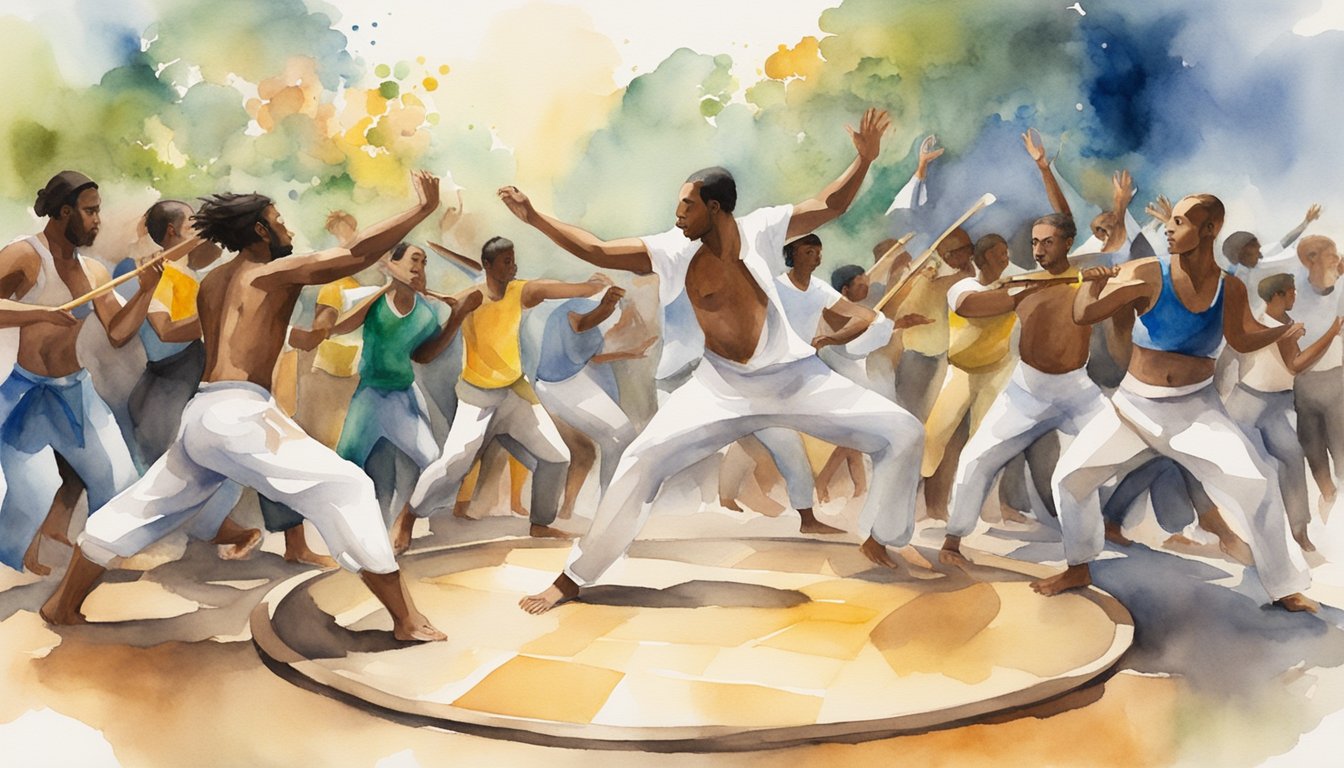Origins and History
Capoeira portrays a vibrant tapestry, interweaving the resilience and creativity of cultures. This martial art embodies the strife for freedom and the ingenuity of the enslaved Africans in Brazil.
African Roots and Brazil’s Influence
The genesis of capoeira is steeped in the rhythms of Africa and the turmoil of Brazilian history. Scholars suggest that the precursors to capoeira originated in the Cunene region of Angola, an area known for various traditional dances and fighting styles. With the tragic advent of the Atlantic slave trade, these practices found new soil in Brazil, fusing with the local culture. Enslaved Africans and their descendants, referred to as Afro-Brazilians, adapted their ancestral movements for self-defense and spiritual resistance on plantations and in quilombos, communities founded by runaway slaves.
During the colonial period, slaves employed capoeira as a means to train for combat, disguised as dance, in their struggle for freedom. Capoeira evolved into a form of resistance, laying the groundwork for what would become a rich cultural legacy, particularly in regions like Bahia. The blend of African fighting techniques with Brazilian influence gave rise to a unique art that was as beguiling in its physical expression as it was potent in its martial capabilities.
The Emergence of Capoeira
By the 20th century, capoeira began to emerge from the shadows of oppression. Mestre Bimba from Salvador, recognized as one of the pivotal figures in capoeira’s history, played an instrumental role in its legitimization. He founded the first capoeira school in 1932, advocating for the practice as a national sport rather than a criminalized street activity. This period marked the transformation of capoeira from a clandestine practice of fugitive slaves in Luanda and other regions to an internationally recognized symbol of Brazilian heritage.
Under government scrutiny, capoeira initially faced harsh restrictions and was often associated with criminal elements. However, with persistence and the shifting tides of cultural appreciation, it gained official recognition. Capoeira, now celebrated as an Afro-Brazilian martial art, encapsulates the philosophy, spiritual beliefs, and creative heartbeat of a people who used movement and music as tools of liberation.
Styles and Techniques

Capoeira blends martial art forms, dance, and music, creating a rich cultural expression that is both a game and a method of self-defense. The technique in Capoeira involves intricate movements that require agility and coordination.
Capoeira Regional and Angola
Capoeira Angola and Capoeira Regional are the two main styles of this Brazilian art form. Capoeira Angola, often associated with Mestre Pastinha, emphasizes slow, strategic movements and traditions dating back to African roots. In contrast, Mestre Bimba’s Capoeira Regional is known for its rapid, athletic movements and the incorporation of acrobatics. Both styles utilize the jogo de capoeira (game of Capoeira), where players engage in a conversation through movement within the roda (circle).
Key Movements in Capoeira
Key movements in Capoeira involve a blend of ginga, the foundational swaying step, and various ataques (attacks) including kicks like meia lua de compasso and martelo. Evasions such as esquivas and acrobatic maneuvers such as au (cartwheel) and handstands are also integral. Instruments play a central role, with the berimbau dictating the rhythm and pace of the game, complemented by the pandeiro (tambourine), agogô (bell), and atabaque (drum).
Players learn to incorporate elements of drama, combat, and dance, utilizing movements influenced by other practices like jiu-jitsu, gymnastics, and even breakdancing. Training focuses on developing flexibility and strength to perform complex techniques such as escorpião (scorpion kick) and rasteira (sweep). Capoeira masters, or mestres, teach their students not just the physical aspects, but also the history and philosophy behind this profound martial art.
Cultural Significance and Modern Practice

Capoeira marries martial arts, dance, and music into a vibrant cultural emblem. As it evolved from its Brazilian roots, the contemporary practice reflects its history while adapting to a global stage.
Capoeira as a Global Sport
Once a clandestine practice of African slaves in Brazil, capoeira has soared as a global sport and cultural phenomenon. In cities like Rio de Janeiro, capoeiristas propel the sport into the future, with gyms and cultural centers fostering a blend of fitness, self-defense, and dance. Characterized by swift moves and non-contact combat, capoeira exudes a sense of malicia, a crafty cleverness, challenging participants to anticipate their opponents’ movements.
The Intracultural and intercultural dynamics of capoeira training continue to shape the sport as it travels, embodying the spirit of a culture trip that brings together people from diverse backgrounds.
Instruments and Music
Capoeira’s soul lies within its unique musical ensemble, essential in any roda, a circle where the game takes place. The berimbaus, resembling a single-stringed bow, are the leading instruments, often accompanied by drums such as the atabaque. This musical narrative of capoeira sets the pace and dictates the style of the game, while songs recount tales of capoeira’s past, infusing the practice with rhythm and history.
Continued Evolution
As capoeira pirouettes into the future, it remains tethered to its roots as a symbol of resistance against oppression. Now recognized as an intangible cultural heritage, capoeira continues to evolve, painting a picture of Brazil’s robust cultural heritage on an international canvas. Mestre Acordeon, a legendary figure in the capoeira community, has been pivotal in this expansion. Literary works and scholarly articles examine how capoeira has transformed from being associated with gangs and blades to becoming a respected element of carioca culture and a well-regarded addition to the world of fitness.

